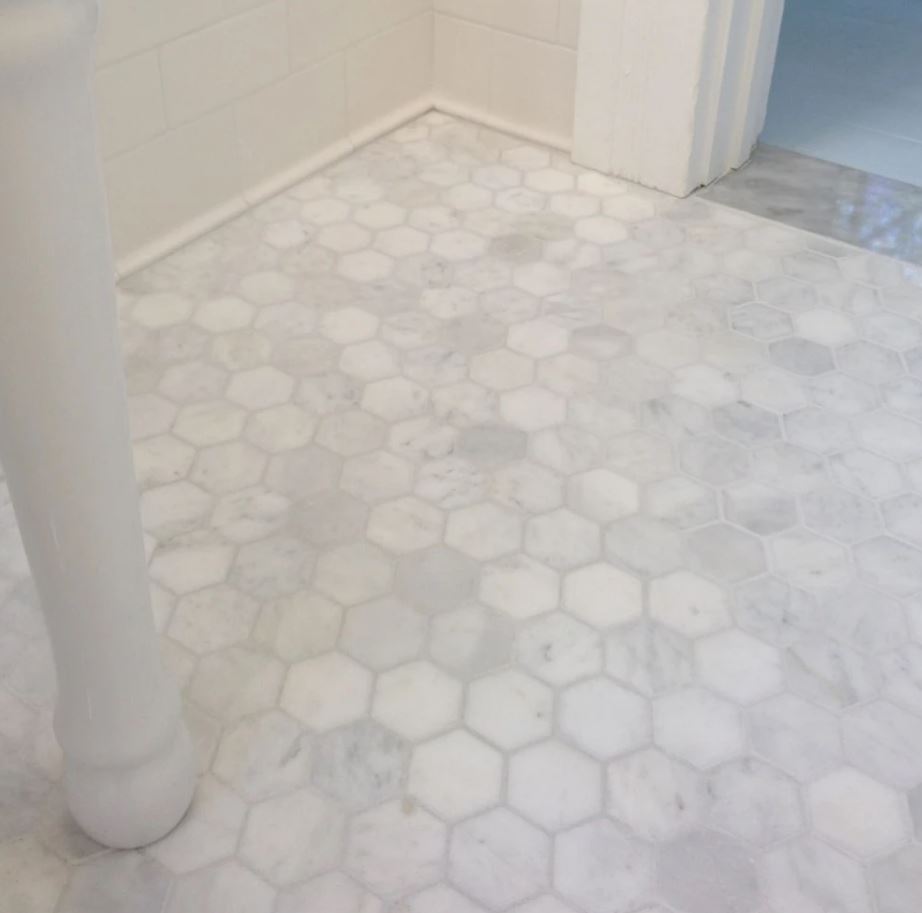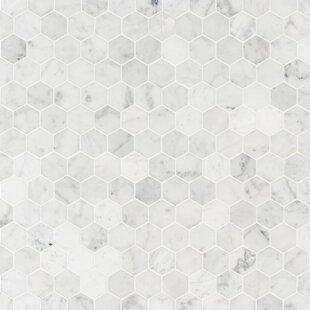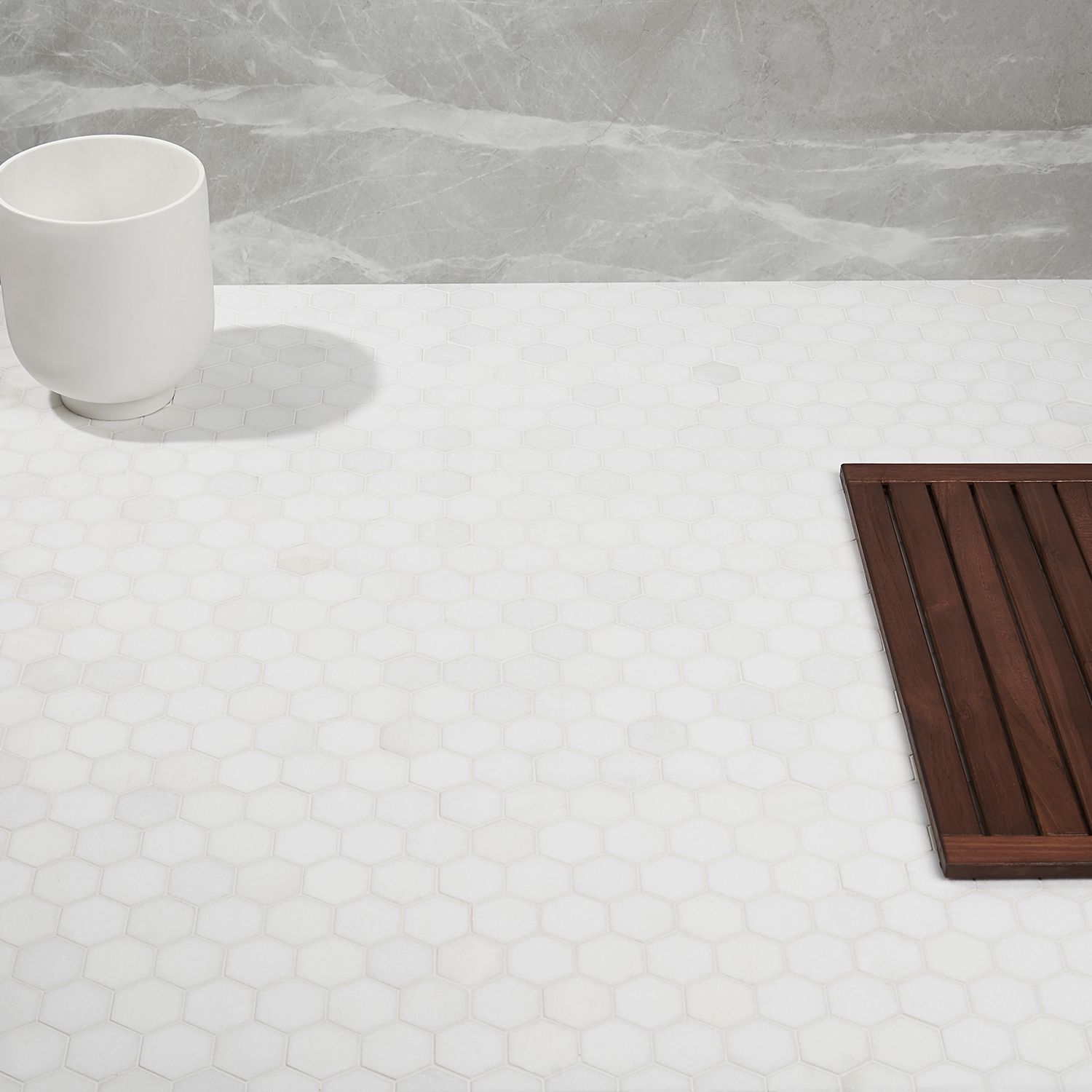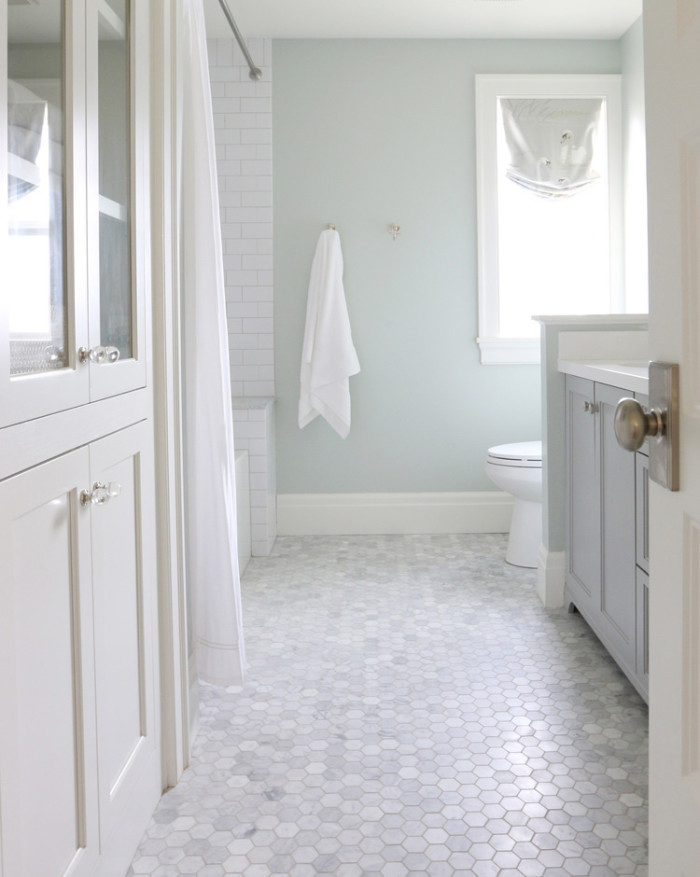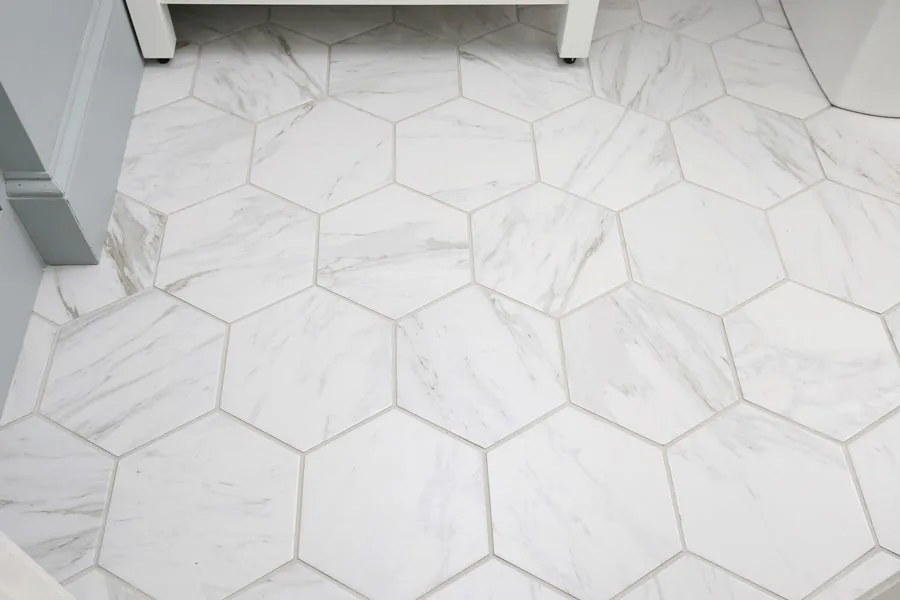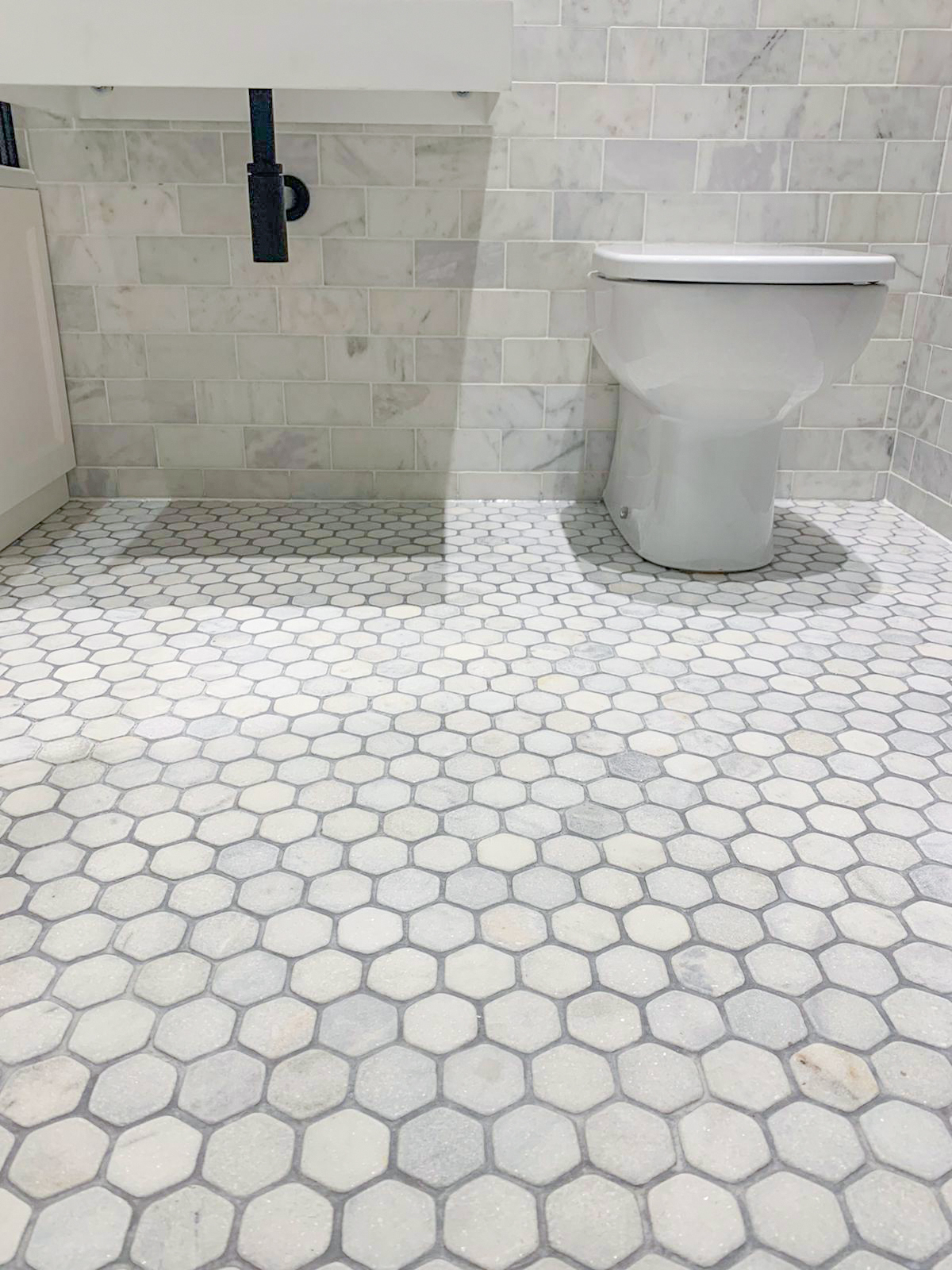Hexagon marble flooring can transform any space into a stunning showcase of elegance and style. The unique shape and natural beauty of marble make it a popular choice for homeowners looking to elevate their interior design. Today we will discuss the advantages of hexagonal tiles, the types of marble best suited for these floors, color variations, installation techniques, grout options, maintenance tips, design ideas, and much more. Let’s explore how hexagon marble flooring can be a game-changer for your home.
Advantages of Hexagonal Tiles Over Other Shapes
- Visual Appeal: Hexagonal tiles have a unique geometric shape that creates visual interest and adds a modern touch to any room. Their six-sided design breaks away from the traditional square or rectangular tiles, offering a fresh and contemporary look.
- Versatility in Design: The hexagon shape allows for endless design possibilities. You can create intricate patterns, such as honeycomb or flower-like designs, by arranging the tiles in different ways. This versatility makes hexagonal tiles suitable for various styles, from classic to contemporary.
- Seamless Transitions: Hexagonal tiles can create seamless transitions between different areas of your home. For instance, you can use hexagon tiles in the bathroom and carry the design into the hallway or kitchen for a cohesive look. This continuity enhances the flow and visual harmony of your space.
- Enhanced Grip and Safety: The smaller size of hexagonal tiles, compared to larger rectangular tiles, provides more grout lines. These additional grout lines can offer better traction and reduce the risk of slipping, making hexagon marble floors a safer choice for wet areas like bathrooms and kitchens.
- Durability and Stability: Hexagonal tiles, especially when made from marble, are incredibly durable and stable. The unique shape distributes weight evenly across the surface, reducing the likelihood of cracks or damage over time. This makes hexagon marble floors a long-lasting investment.
- Easy Customization: Hexagonal tiles can be easily customized to fit any space, regardless of size or shape. They can be cut to fit around fixtures, edges, and corners, ensuring a perfect fit and a polished finish. This flexibility allows for a tailored design that meets your specific needs.

Types of Marble Suitable for Hexagon Floors
Carrara Marble: Carrara marble is one of the most popular choices for hexagon floors due to its classic white color and subtle gray veining. It offers a timeless and elegant look that can brighten up any space. Carrara marble is also relatively affordable compared to other types of marble.
Calacatta Marble: Calacatta marble is known for its bold and dramatic veining, which ranges from gold to gray. This luxurious marble type is perfect for creating a statement floor that exudes opulence and sophistication. Its unique patterns make each hexagon tile a work of art.
Statuario Marble: Statuario marble is similar to Carrara but features more pronounced and dramatic veining. It is often used in high-end applications due to its stunning appearance and rarity. Statuario marble hexagon tiles can add a touch of luxury to any room.
Nero Marquina Marble: For those looking for a bold and striking floor, Nero Marquina marble is an excellent choice. This black marble with white veining creates a high-contrast look that adds depth and drama to any space. It’s perfect for modern and contemporary designs.
Emperador Marble: Emperador marble comes in light and dark varieties, both featuring rich brown tones and intricate veining. This type of marble adds warmth and elegance to a room, making it a great choice for traditional and classic interiors.
Thassos Marble: Thassos marble is known for its pure white color and minimal veining. It has a clean and crisp appearance that can make a space feel larger and more open. Thassos marble hexagon tiles are ideal for creating a minimalist and serene environment.
Color Variations and Patterns
Classic White and Gray: Classic white marble with gray veining is a timeless choice that can complement any design style. The subtle veining adds texture and interest without overwhelming the space. This color combination is versatile and can be used in both traditional and modern interiors.
Bold and Dramatic: For those looking to make a statement, bold color variations like black marble with white veining or deep green marble can create a striking focal point. These dramatic colors add depth and character to a room, making the floor the star of the show.
Soft and Subtle: Soft color variations, such as beige or light gray marble, offer a more understated and elegant look. These neutral tones can create a calming and serene atmosphere, perfect for spaces like bathrooms or bedrooms where relaxation is key.
Mixed Patterns: Combining different colors and patterns of hexagon marble tiles can create a unique and personalized floor design. For example, mixing white and black marble tiles in a checkerboard pattern or blending different shades of gray can add visual interest and depth to the floor.
Veining Patterns: The veining in marble can range from subtle and delicate to bold and dramatic. Choosing tiles with varying veining patterns can create a dynamic and textured floor that adds dimension to the space. Each hexagon tile can showcase different veining, making the floor truly one-of-a-kind.
Bookmatching and Mirror Imaging: Bookmatching is a technique where two adjacent marble tiles are cut from the same slab and placed next to each other, creating a mirror image. This technique can be used to create stunning symmetrical patterns on the floor, adding a sense of luxury and artistry to the design.
Installation Techniques and Challenges
Surface Preparation: Before installing hexagon marble tiles, it’s crucial to prepare the surface properly. The substrate must be clean, level, and free of any cracks or imperfections. This ensures a stable base for the tiles and prevents issues like lippage (uneven tile edges) and cracking.
Layout Planning: Planning the layout is essential for a successful installation. Dry-lay the hexagon tiles to determine the best placement and pattern. This helps in visualizing the final look and allows for adjustments before the tiles are permanently set.
Cutting the Tiles: Cutting hexagon tiles can be challenging due to their shape. A wet saw with a diamond blade is recommended for precise cuts. Take accurate measurements and cut slowly to avoid chipping or cracking the tiles. Patience and precision are key to achieving clean edges.
Setting the Tiles: Use a high-quality thin-set mortar to set the tiles. Apply the mortar evenly with a notched trowel and press each tile firmly into place. Use tile spacers to maintain consistent spacing between the tiles. Work in small sections to ensure the mortar does not dry out before the tiles are set.
Dealing with Edges and Corners: Edges and corners can be tricky when installing hexagon tiles. Use smaller pieces or specially cut tiles to fit around edges and corners. Ensure that the cuts are precise and that the tiles fit snugly to maintain the overall pattern.
Allowing for Movement: Marble is a natural stone that can expand and contract with temperature changes. To prevent cracking, it’s important to leave a small gap around the perimeter of the installation. This gap, known as an expansion joint, allows for movement and should be filled with a flexible material like silicone caulk.
Grout Options and Their Impact on the Overall Look
Color Matching: Choosing a grout color that matches the marble tiles can create a seamless and cohesive look. This option highlights the beauty of the marble and allows the tiles to take center stage. Matching grout is ideal for a clean and elegant appearance.
Contrasting Colors: Using a contrasting grout color can add definition and emphasize the hexagonal shape of the tiles. For example, white marble with black grout creates a striking contrast that highlights the geometric pattern. This option adds a bold and modern touch to the design.
Neutral Tones: Neutral grout colors, such as gray or beige, offer a balanced and versatile look. They blend well with various marble colors and veining patterns, creating a harmonious design. Neutral grout is a safe choice that complements the natural beauty of the marble.
Epoxy Grout: Epoxy grout is highly durable and resistant to stains and moisture. It is an excellent choice for areas prone to spills and moisture, such as kitchens and bathrooms. Epoxy grout is available in various colors and offers long-lasting performance.
Sanded vs. Unsanded Grout: Sanded grout contains sand particles and is suitable for larger grout lines, while unsanded grout is smoother and used for smaller grout lines. The choice between sanded and unsanded grout depends on the width of the grout lines and the desired finish.
Sealing the Grout: Sealing the grout is essential to protect it from stains and moisture. A high-quality grout sealer creates a protective barrier that keeps the grout looking fresh and clean. Regular resealing is recommended to maintain the durability and appearance of the grout.
Maintenance and Care
Regular Cleaning: Regular cleaning is essential to keep hexagon marble floors looking their best. Use a soft mop or a microfiber cloth to remove dust and debris. Avoid using abrasive cleaners or tools that can scratch the marble surface.
Using pH-Neutral Cleaners: Marble is sensitive to acidic substances, which can cause etching and damage. Use pH-neutral cleaners specifically designed for marble to clean the floors. These cleaners are gentle on the marble and effectively remove dirt and grime.
Spill Management: Promptly clean up any spills to prevent staining and etching. Use a soft cloth to blot the spill and avoid rubbing, which can spread the stain. For tougher stains, use a marble-safe stain remover and follow the manufacturer’s instructions.
Sealing the Marble: Sealing the marble floor creates a protective barrier that prevents stains and moisture penetration. Apply a high-quality marble sealer according to the manufacturer’s instructions. Regular resealing, typically every 6 to 12 months, is recommended to maintain the protection.
Preventing Scratches: Place felt pads under furniture legs to prevent scratches on the marble floor. Avoid dragging heavy objects across the floor, and use rugs or mats in high-traffic areas to protect the marble from wear and tear.
Dealing with Etching and Stains: If the marble floor becomes etched or stained, use a marble polishing powder or a professional marble polishing service to restore the surface. These products and services can remove minor scratches and etching, restoring the marble’s natural shine.
Design Ideas and Layout Patterns
Classic Honeycomb: The classic honeycomb pattern is a popular choice for hexagon marble floors. This pattern creates a seamless and continuous design that adds visual interest without overwhelming the space. It’s versatile and works well in both traditional and modern interiors.
Border and Inlay Designs: Adding borders or inlays to the hexagon marble floor can create a custom and luxurious look. Use contrasting marble colors or materials to create intricate borders or inlay designs that frame the floor and add a decorative touch.
Mixed Sizes and Shapes: Mixing hexagon tiles with other shapes, such as squares or rectangles, can create a unique and personalized design. This approach adds dimension and complexity to the floor, making it a focal point in the room.
Geometric Patterns: Create geometric patterns by arranging hexagon tiles in different orientations. For example, alternating the direction of the tiles can create a dynamic and eye-catching pattern. Geometric patterns add a modern and artistic touch to the design.
Randomized Layouts: A randomized layout using different colors and patterns of hexagon tiles can create a whimsical and playful floor design. This approach adds character and uniqueness to the space, making each section of the floor stand out.
Combining with Other Materials: Combining hexagon marble tiles with other materials, such as wood or metal, can create a striking contrast and add texture to the design. For example, using wood accents around the hexagon tiles can create a warm and inviting look.
Combining Hexagon Marble with Other Materials or Tile Shapes
Wood and Marble: Combining hexagon marble tiles with wood creates a beautiful contrast between the cool, sleek marble and the warm, natural wood. This combination works well in transitional and contemporary designs, adding a touch of sophistication and warmth.
Metal and Marble: Incorporating metal elements, such as brass or stainless steel, with hexagon marble tiles can create a luxurious and modern look. Metal accents can be used in borders, inlays, or as fixtures, adding a touch of glamour to the design.
Glass and Marble: Combining glass tiles with hexagon marble tiles can create a light and airy feel. Glass tiles can be used as accents or in combination with marble tiles to create a unique and reflective design that enhances the natural light in the room.
Ceramic and Marble: Mixing ceramic tiles with hexagon marble tiles can add texture and variety to the floor. Ceramic tiles come in various colors and patterns, allowing for creative combinations that add visual interest and depth to the design.
Concrete and Marble: Combining concrete with hexagon marble tiles creates an industrial-chic look that is both modern and sophisticated. The rough texture of concrete contrasts beautifully with the smooth, polished marble, adding an edgy and contemporary touch.
Mosaic and Marble: Incorporating mosaic tiles with hexagon marble tiles can create intricate and detailed designs. Mosaic tiles can be used to create borders, inlays, or decorative patterns that add complexity and artistry to the floor.
Cost Considerations and Budgeting
Material Costs: The cost of hexagon marble tiles varies depending on the type of marble and its quality. High-end marbles like Calacatta or Statuario are more expensive than Carrara or Emperador. Consider the cost per square foot and the total area to determine the material budget.
Installation Costs: Professional installation can add to the overall cost of the project. Factors such as the complexity of the design, the condition of the substrate, and the region can affect installation prices. Obtain quotes from reputable installers to budget accurately.
Preparation and Removal: Preparing the surface and removing existing flooring can incur additional costs. This includes leveling the substrate, repairing any damage, and disposing of old materials. Factor these expenses into your overall budget.
Grout and Sealing: The cost of grout, sealers, and other finishing materials should be included in the budget. High-quality grout and sealers can enhance the durability and appearance of the marble floor, making them a worthwhile investment.
Maintenance Costs: Budget for ongoing maintenance to keep the hexagon marble floor looking its best. This includes regular cleaning supplies, resealing products, and potential professional polishing services. Regular maintenance ensures the longevity and beauty of the floor.
Contingency Fund: Set aside a contingency fund for unexpected expenses that may arise during the project. This could include additional materials, unforeseen repairs, or changes in design. A financial buffer helps manage any surprises without compromising the quality of the installation.
Durability and Longevity
Natural Durability: Marble is a naturally durable stone that can withstand heavy foot traffic and everyday wear and tear. When properly installed and maintained, hexagon marble floors can last for decades, providing a long-term investment in your home’s value.
Scratch and Impact Resistance: While marble is durable, it can be susceptible to scratches and impacts. Using protective measures, such as placing mats in high-traffic areas and using furniture pads, can help prevent damage and maintain the floor’s appearance.
Moisture Resistance: Marble is naturally resistant to moisture, making it suitable for areas like bathrooms and kitchens. However, it’s essential to seal the marble properly to prevent water penetration and staining. Regular resealing ensures the marble remains protected.
Heat Resistance: Marble is heat resistant, making it an excellent choice for areas with fluctuating temperatures. It can withstand high heat without damage, making it suitable for use near fireplaces or in areas with radiant floor heating systems.
Stain Resistance: Marble can be prone to staining, especially from acidic substances. Regular sealing and prompt cleaning of spills can prevent stains from setting in. Using coasters and placemats can also protect the marble from spills and stains.
Timeless Beauty: One of the most significant advantages of marble is its timeless beauty. Unlike other flooring materials that may go out of style, marble remains a classic and elegant choice that enhances the aesthetic appeal of any space. Its natural variations and patterns ensure that no two floors are exactly alike.
Calacatta Tumbled Hexagon Marble Mosaic Fast Delivery Starel
Related Posts:

